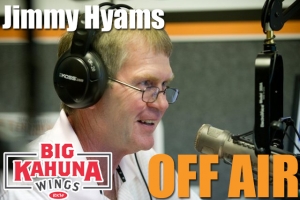
By Jimmy Hyams
Tennessee’s run defense was historically bad last season.
The Vols allowed 218.5 rushing yards per game, 5.0 yards per carry. It allowed four of its last six SEC opponents to rush for at least 350 yards. Three had over 400.
Injuries took a tool, but so did missed tackles and misalignments.
Any coach will tell you it’s tough to win if you can’t contain the run game.
That is Tennessee’s No. 1 challenge this season.
“Stopping the run, to me, is always the No. 1 thing you have to do (on defense),’’ said Tennessee defensive line coach Brady Hoke. “And you’re not going to stop the run unless everybody understands where the fits are and what different strengths and weakness each defensive call may have.’’
Tennessee’s run defense was 10th in the SEC. The team that won the West, Alabama, allowed a mere 63.9 rush yards per game. Florida, which won the East, allowed 144.5 per game. Alabama and Florida combined to surrender 21 rushing touchdowns. Tennessee gave up 28.
Can you make drastic improvement in run defense from one year to the next?
Hoke is hopeful.
“The whole thing about the defensive line, in my opinion, philosophically, is the toughness that they have because if you’re going to win a championship you’re going to win with guys you’ve got up front on both sides of the ball,’’ Hoke said.
“We’ve got to be very intense, have a purpose every day … to improve. We’ve got a ton of work to do.’’
But does Hoke have the personnel to get it done? Remember, the Vols lost all-time sacks leader Derek Barnett as well as two other productive defense ends, LaTroy Lewis and Corey Vereen, and tackle Danny O’Brien, who was dismissed from the team in October.
“Not to dodge the question, but I think it’s hard for me to say that,’’ Hoke said. “Obviously you go back and look at tape before some of these guys got injured and you see (tackle) Shy Tuttle doing some really good things and you see (tackle) Kahlil McKenzie doing some good things. You see (tackle Kendal) Vickers doing some good things ….
“I’m encouraged. I’m excited about this group. I’m excited about the guys coming back and I’m excited about some of the young guys coming in.’’
Some of the other top returners: ends Jonathan Kongbo, Kyle Phillips, Darrell Taylor.
Stopping the run starts with the defensive line, but it doesn’t end there.
“We need 11 guys flying to the football,’’ Hoke said. “That’s how you stop those big plays and that’s how you don’t give up 5.0 yards per rush.’’
“There’s 11 guys out there. It’s not a one-man solo sport by any means. I’ve always believed part of stopping the run is understanding what the support is, who’s the chase player, gap integrity, getting off blocks inside the gap zone.
“Everyone has a responsibility. Everybody has got an assignment. But the more we realize the strengths and weaknesses of each defensive call, I think we’ll play faster. And as you play faster, you will play better as a unit.’’
The yards-per-rush number was inflated because the Vols allowed so many explosive runs: six for 62 yards or more, four for 71 or more, one for 85. There were seven more runs of 37 or more yards.
Defensive coordinator Bob Shoop said the Vols allowed too many “catastrophic plays’’ but defended his play calling: “I don’t think it was any Xs or Os or schemes.’’
Shoop added: “We’ve got to minimize those (big) plays. We’ve got to run to the ball better. We’ve got to beat blocks. We’ve got to tackle battler. We’ve got to play better fundamental football.
“No defense can statistically overcome 60- and 70-yard runs. It’s hard to do.’’
Big Kahuna Wings: The wings that changed it all




















